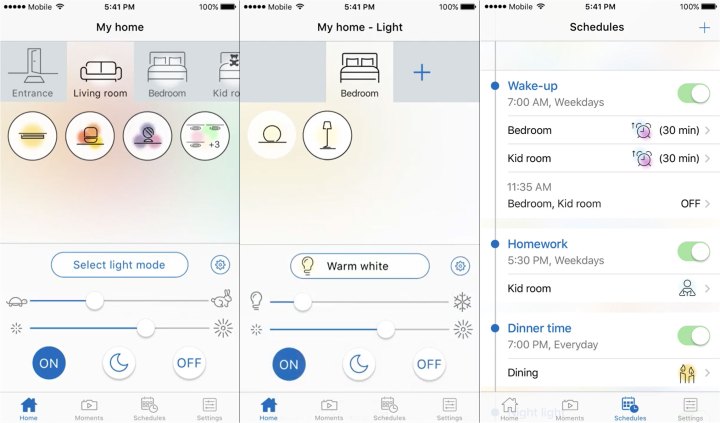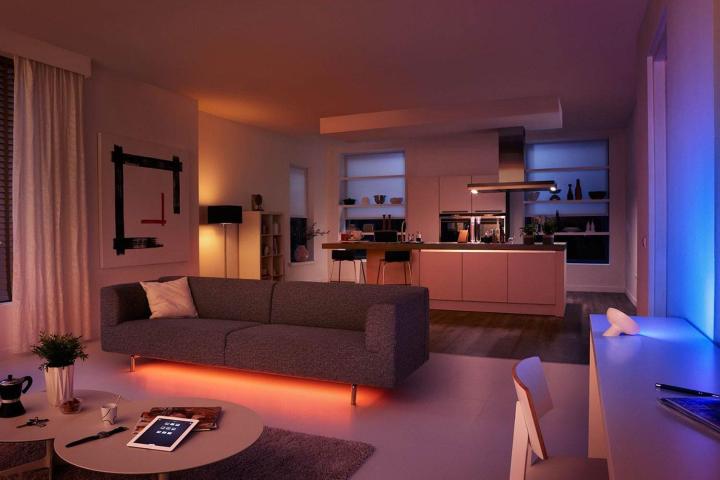If you’re just getting started with smart light bulbs in your home, Philips Hue is one of the names likely on your radar. This brand has become synonymous with smart home lighting thanks to robust app support, a wide range of functions, and a routinely growing product lineup. What may confuse you when taking the plunge on a purchase is seeing another Philips brand on the store shelf called WiZ. In 2019, Signify (the lighting company spun off from Philips proper) acquired WiZ to bolster its lighting lineup. Unfortunately, WiZ and Hue smart light bulbs operate differently, so you really need to go all-in with one or the other to have a properly unified smart home lighting setup.
Hue uses a wireless standard called Zigbee, which has been around for a while as a means for low-power connections. Zigbee devices run on a different frequency than Wi-Fi and require their own physical hub. This hub connects to a Wi-Fi router, which in turn connects to your phone. The internet connection also allows for remote connectivity, so lights can turn off automatically as you leave the house, for example. Since its launch, Hue has added Bluetooth to its bulbs, so the hub isn’t strictly necessary. Though the Bluetooth range is basically limited to within the same room as you, this can save the bit of time it takes to connect to the hub via Wi-Fi.
WiZ dispenses with Zigbee altogether. Instead, WiZ smart bulbs connect directly to your router over Wi-Fi. During setup, they produce their own little Wi-Fi hotspot that you connect to, if only to relay the credentials for your home Wi-Fi network. If you’ve ever set up a Chromecast, it’s the same idea. That’s one less hoop to jump through than Philips Hue, making setup and expansion a bit easier. The WiZ mobile app is also different than Hue’s, offering more functions in some areas and fewer in others.
Let’s compare these two platforms and figure out which is best for you.
Function

Functionally, Philips Hue and WiZ are similar. Standard E12, E26, and GU10 sockets are available for both. Hue has a few more bulb form factors by way of finished lamps. The color and brightness range across brands is equally broad. Setting up schedules, room organization, and color recipes are on par. Both can activate with commands through Google Assistant, Amazon Alexa, and Siri. Third-party support is a little stronger for Hue, with apps like Hue Pro providing animation capabilities beyond the Philips app. That said, the native WiZ app has some unique features out of the box, such as energy consumption tracking and setting transition interval times. Some of those animation features in Hue Pro are baked right into the WiZ app.
Partnerships with Spotify for music sync and a strong play in TV backlighting give Hue the edge over WiZ, but these are fairly advanced features that aren’t necessarily a big selling point for everyone. For low-key users, WiZ has an ample feature set that should meet day-to-day demands.
Longevity considerations

The real worry is the long-term support, which is highly valuable for a product that’s going to be part of your home for years to come. The last thing you want is to spend the money and energy of installing smart lights only to have the app (and most functions of the lights) cease to function a few years down the line. Some smart home companies, like Sonos, have shown that they won’t allow that to happen.
A stable brand might seem like it has a strong likelihood of keeping smart lights operable for the long haul, if only by sheer virtue of staying in business long enough, but it may just as likely shoulder you into arbitrary upgrades. For example, Hue has already turned off voice commands and app updates for any lights connected to its first-generation hub in an effort to get owners to buy their V2 hub. You could make arguments for the technical necessity of these updates, but for those of us investing in LED for the sake of the environment, it’s not great knowing we’ll be expected to bin one of our hubs every few years. For what it’s worth, Hue smart light bulbs on the 9-year-old first-generation hub still provide plenty of utility, if not its original full feature set.
As for WiZ, being hubless gives it the benefit of one less point of potential failure when it comes to support and obsolescence. However, as a smaller brand, its ability to stick around long enough to keep the app working is a little lower. One could argue these two factors cancel each other out.
Price
The price difference between Philips Hue and WiZ is quite stark and is likely the deciding factor between these two product families.
One of the Hue starter kits with four color bulbs and the hub goes for $270. The cheapest single white Hue bulb is $25. Meanwhile, a four-pack of color WiZ bulbs is only $50, and you can snag a single white one for only $13/cc-placement].
While WiZ bulbs may be cheaper, stock may be harder to find. Amazon is currently not listing any of the color bulbs, and Costco only has the four-packs of the bulged reflector models. So, most likely you’ll need to pick up WiZ smart light bulbs at Home Depot to fully flesh out your lighting setup.
The reduced availability gives the impression that Signify may be winding down WiZ in favor of Hue, but a whole new batch of WiZ bulbs were recently announced. We can expect both lineups to continue into the future and provide much-needed ongoing software support.
Conclusion
The bottom line here really comes down to price. There are a few things Hue does better, and fewer things WiZ does better. Advanced features like TV and music sync may tip the scales in favor of Hue. Those functional differences are minor compared to the stark price disparity. You can save a few bucks with WiZ and not miss out on too much.



